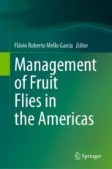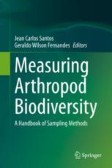Search
Search Results
-
Bases for Management of Fruit Flies (Diptera: Tephritidae) in Uruguay
In Uruguay, there are two fruit fly species of major economic and quarantine importance Ceratitis capitata and Anastrepha fraterculus (Diptera,...
-
Global drivers of historical true fruit fly (Diptera: Tephritidae) invasions
Given the high costs associated with fruit fly (Tephritidae) invasions, there is a need to better understand and predict the risks of future...

-
Management of Economically Important Native and Exotic Fruit Fly (Tephritidae) Species in Mexico
Fruit fly (Tephritidae) control/management has a long history in Mexico that spans from the beginning of the nineteenth century to date. In several...
-
Enterobactereaceae symbiont as facilitators of biological invasion: review of Tephritidae fruit flies
Insects harbor a diversity of microbes that are known to affect their host’s response to biotic and abiotic stressors. This is important in the...

-
Efficacy of different entomopathogenic nematode isolates, against the peach fruit fly, Bactrocera zonata (Saund.) (Diptera: Tephritidae)
BackgroundThe invasive peach fruit fly (PFF), Bactrocera zonata (Saunders) (Diptera: Tephritidae), is a native of Southeast Asia. Entomopathogens...

-
Utilisation of a mitochondrial intergenic region for species differentiation of fruit flies (Diptera: Tephritidae) in South Africa
BackgroundFruit flies (Diptera: Tephritidae) comprise species of agricultural and economic importance. Five such fruit fly species are known to...

-
Attractancy of a Sesquiterpene, β-caryophyllene to Males of the Oriental Fruit Fly, Bactrocera dorsalis (Diptera: Tephritidae)
The recent discovery of a sesquiterpene, β-caryophyllene (CP) as a male attractant of the guava fruit fly, Bactrocera correcta (Bezzi) (Diptera:...
-
Life-history traits of Dacus frontalis Becker (Diptera: Tephritidae) reared at four constant temperatures
Dacus frontalis (Diptera: Tephritidae) is an emerging species affecting fruit production in Africa and may pose a serious risk to the Cucurbitaceae...

-
Natural Oil Lure Outperforms Trimedlure in Capturing Males of the Mediterranean Fruit Fly, Ceratitis capitata (Diptera: Tephritidae)
Females of certain tephritid fruit fly species (Diptera: Tephritidae) pose an enormous agricultural threat, as they oviposit in commercially...

-
Development of microsatellite markers for the Japanese orange fly, Bactrocera tsuneonis (Diptera: Tephritidae)
To monitor and control the Japanese orange fly Bactrocera tsuneonis (Miyake) (Diptera: Tephritidae), it is important to determine their dispersal...
-
Effects of Physiological Status and Environmental Factors on the Lure Responses of Three Pest Fruit Fly Species (Diptera: Tephritidae)
Biotic and abiotic factors influence how insects respond to stimuli. This can make it challenging to interpret captures in traps used to monitor pest...

-
Biology, ecology and control of the Mediterranean fruit fly, Ceratitis capitata (Diptera: Tephritidae), with special reference to biological control using entomopathogenic nematode (EPN): a review
BackgroundCeratitis capitata (Wiedemann, 1824) (Diptera: Tephritidae) is a polyphagous, holometabolous and multivoltine insect that has spread from...

-
Biological Control Introductions Against Invasive Tephritid Fruit Flies (Diptera: Tephritidae) in the US: Achievements, Opportunities, and Challenges
Biological control introduction is one of the safest, most environmentally benign, and cost-effective methods for sustainable and landscape-level...
-
Determination of Preference of Tree Direction and Orchard Direction of Cherry Fruit Fly, Rhagoletis cerasi L. (Diptera: Tephritidae)
This study was carried out to determine the preference of tree direction and orchard direction of the Cherry fruit fly, Rhagoletis cerasi L....

-
Sampling Methods of True Fruit Flies (Tephritidae)
True fruit flies (Tephritidae) belong to a highly diverse family of Diptera inhabiting nearly all tropical, subtropical, and temperate regions...
-
Which artificial larval diet is better for Ceratitis capitata (Diptera: Tephritidae) rearing?
BackgroundThere is an increasing demand for biological agents for integrated pest management programs, requiring a constant supply of insects in...

-
Repellent activity of Salix alba bark extract and guava oil-based formulation against the oriental fruit fly, Bactrocera dorsalis (Diptera: Tephritidae)
Bactrocera dorsalis (Diptera: Tephritidae), the primary pest of guava ( Psidium guajava ), damages numerous horticulture fruits in tropical and...

-
Horizontal transmission of Beauveria bassiana spores using infected males and inoculation device: impact on survival and fecundity of Ceratitis capitata (Diptera: Tephritidae)
The mode of transmission of fungus spores (horizontal transmission or assisted auto-dissemination) directly influences the effectiveness of a fungal...

-
Pathogenicity of Rhizobateria Pseudomonas against Ceratitis Capitata Wiedemann (Diptera: Tephritidae)
The Mediterranean fruit fly, Ceratitis capitata (Wiedemann) (Diptera, Tephritidae), is one of the most destructive insect pests of citrus in the...

-
Pathogenicity of Beauveria bassiana (Balsamo-Crivelli) and Metarhizium anisopliae (Metschnikoff) isolates against life stages of Zeugodacus cucurbitae (Coquillett) (Diptera: Tephritidae)
BackgroundEntomopathogenic fungi are primary pathogens that naturally affect insect pests by suppressing their populations and considered as an...

